The Buckinghamia is an Australian Native Tree which grows naturally in Tropical Queensland, in Northern Australia. It is a great small tree for temperate and warm climate gardens , but grows much larger in it's natural habitat in the rainforest where it competes for sunlight with other trees. The main features of the plant are it's unique long ivory-coloured flowers which apper in late Summer and autumn , and the glossy attractive green leaves. This tree is also relatively pest and disease free. The flowers have a nice fragrance and are also attractive to birds and bees. I photographed these Buckinghamia Trees in Sydney a few months ago.

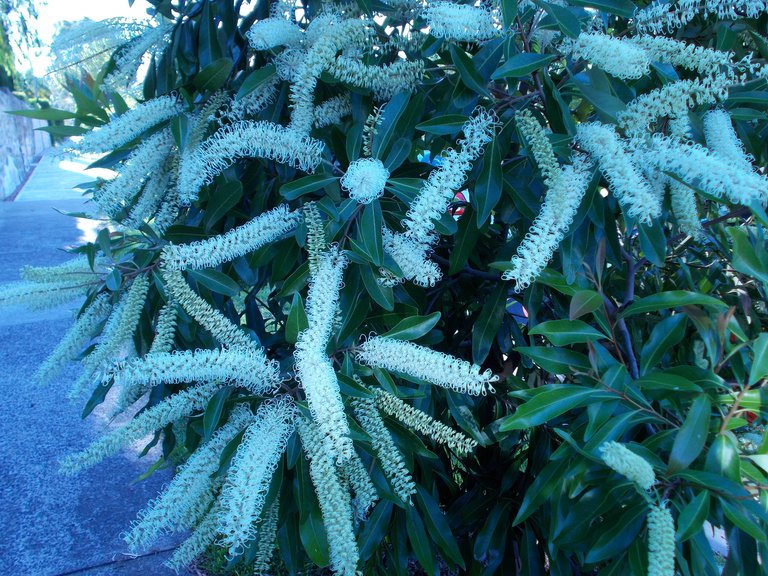
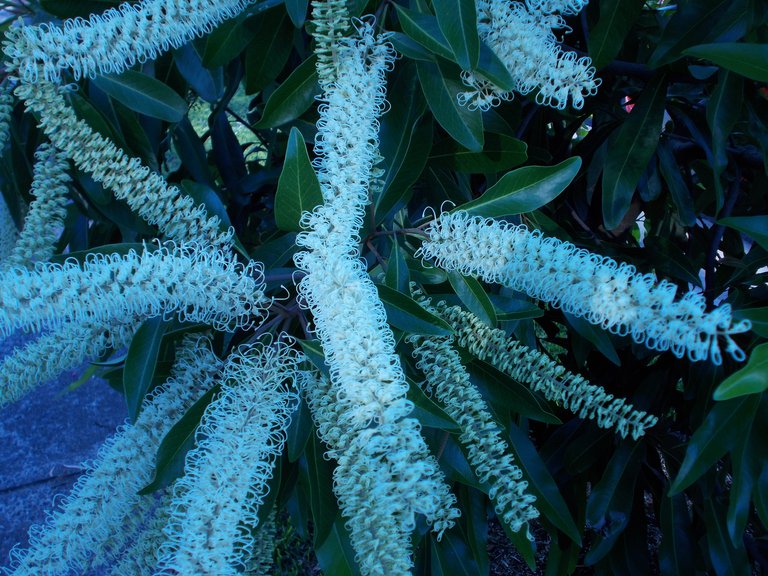
Buckinghamia - The ivory Curl Flower!
The Ivory Curl is a beautiful feature tree often seen in the backyards and found in undisturbed bushland in its native area. According to the Australian Native Plants Society, the tree is named after Richard Greenville, the Duke of Buckingham. You can pllant these beauties in mulched soil and keep them happy with plenty of sun and water. Cuttings will grow faster than seeds, and with less risk of failure. As mature trees, they need less water and are marvellously drought-resistant, and they do not generally require pruning.
Ivory curls can grow up to 7 meters in height, although different climates may reduce its growth, causing it to reach shorter heights. It takes about 3 to 5 years to reach maturity for flowering. The tree has a skinny grey trunk, with the branches forming a rounded shape at the top. The leaves are longish and dark green, with tips that can vary in colour throughout the year from silver to red. But the crowning glory of this tree is its magnificent, profuse ivory/pale yellow cylindrical flowers. These are so plentiful in number and clustering that they can appear to beautifully overwhelm the tree. Bees 🐝, honey eaters and insectivorous birds are attracted to this tree.
Text from multiple Google sources
Congrats, you won the Silly Sausage Award for your great pics and info. Well done !
Wow 😮!!!
Have a great day! Thank you so much @ctrl-alt-nwo!
So unique, somehow reminds me of an anime movie. They would fit in those landscapes perfectly.
Buckinghamia celsissima is commonly called the Ivory Curl Tree. It's a native of North Eastern Queensland, and for years was widely planted as a street tree around Brisbane.
In flower, it's stunning and a great plant for most gardens. The trees grow naturally in rainforests in Queensland and northern New South Wales, but also grow happily throughout most of Australia, including as far south as Melbourne. However Buckinghamia celsissima doesn't do well in Canberra, because it hates frosts, and it will not flower in the humidity and heavy rains of the northern tropics.
In its natural rainforest it grows to about 25 metres to reach the light above the tree canopy. In suburban gardens expect a small tree up to about eight metres, and in the cooler southern states it will reach the size of a medium shrub. The long creamy re-curved flowers are borne in autumn, have a wonderful fragrance and are also attractive to birds and bees.
Buckinghamia celsissima is a great plant - it doesn't seem to suffer pests and diseases, is adaptable and will grow in many areas of Australia.
Source
Congrats, you won the Fav. comment Award. Great pics and info there, well done !
Buckinghamia celsissima is commonly called the Ivory Curl Tree. It's a native of North Eastern Queensland, and for years was widely planted as a street tree around Brisbane.
In flower, it's stunning and a great plant for most gardens. The trees grow naturally in rainforests in Queensland and northern New South Wales, but also grow happily throughout most of Australia, including as far south as Melbourne. However Buckinghamia celsissima doesn't do well in Canberra, because it hates frosts, and it will not flower in the humidity and heavy rains of the northern tropics.
In its natural rainforest it grows to about 25 metres to reach the light above the tree canopy. In suburban gardens expect a small tree up to about eight metres, and in the cooler southern states it will reach the size of a medium shrub. The long creamy re-curved flowers are borne in autumn, have a wonderful fragrance and are also attractive to birds and bees.
Buckinghamia celsissima is a great plant - it doesn't seem to suffer pests and diseases, is adaptable and will grow in many areas of Australia.
I like Gardening!!!
This is my hobby,,
I have a garden,There i cultivate many flower like rose,nightqueen,marigold etc..
@habiba234 Why not post pictures of this garden and maybe just a little info about each flower. Please let me know if you in a comment, I will try to see it and support. If I don't remind me, it is ok.
Really sir you so great man.
You my most choice man @streetstyle
Oh,,Okay @streetstyle,,I will give some photos of my garden!! thanks for @vote
Really sir you so great......
I am your every post upvote done...... best of luck
your doing great work i also love garden but i do not have any garden....
Buckinghamia celsissima is commonly called the Ivory Curl Tree. It's a native of North Eastern Queensland, and for years was widely planted as a street tree around Brisbane.
In flower, it's stunning and a great plant for most gardens. The trees grow naturally in rainforests in Queensland and northern New South Wales, but also grow happily throughout most of Australia, including as far south as Melbourne. However Buckinghamia celsissima doesn't do well in Canberra, because it hates frosts, and it will not flower in the humidity and heavy rains of the northern tropics.
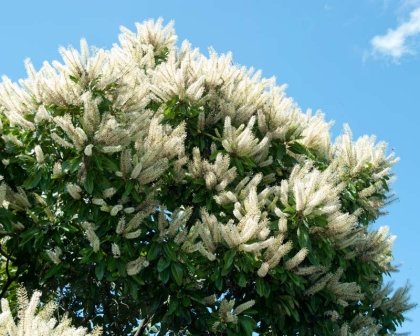
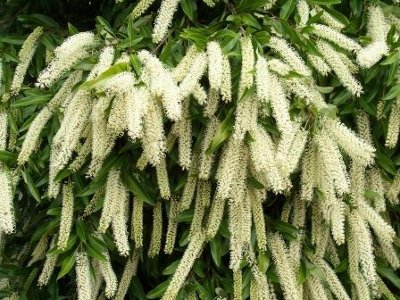
In its natural rainforest it grows to about 25 metres to reach the light above the tree canopy. In suburban gardens expect a small tree up to about eight metres, and in the cooler southern states it will reach the size of a medium shrub. The long creamy re-curved flowers are borne in autumn, have a wonderful fragrance and are also attractive to birds and bees.
Buckinghamia celsissima is a great plant - it doesn't seem to suffer pests and diseases, is adaptable and will grow in many areas of Australia.
source
Magoo-2 found a series of multi accounts of a same owner is following your articles to cheat your generous rewards.
Magoo-2 found these accounts are suspicious & can be multi accounts of a single owner. Conclusion is based on last 30 days transactions:
@afzaal4 @zakir705
magoo-2
Check our latest multi comment spam update report
you are a piece of shit, i sent him sbd because he paid me for it.. Are u in sense???
he is doing shit he did not know any thing he is doing spam....
he is out of his mind
@sardar-sani, report that shit pot over here: http://steemcleaners.com/reports/new
This is a stunning plant in cultivation where it grows into a spectacular flowering medium to large shrub or small tree. In the wild in the rainforests of north Queensland it can grow into a small to medium sized tree but it rarely grows beyond shrub dimensions in cultivation, particularly in cooler climates such as Melbourne.
It is very popular in cultivation and with its glossy dark green leaves, bronze new growth and spectacular cream flowers it makes a beautiful addition to your garden. The species is cultivated in both tropical and temperate areas and is hardy as far south as Melbourne. It is frost tender when young, but damaged growth is quickly replaced in the spring. It likes water during dry periods and regular fertilising, prefers a sunny position and well-drained soil.
The flowers are a magnet for insects which will, in turn, attract insectivorous birds to your garden. If you throw in a birdbath you'll create a summer paradise for your local birds.
source- https://www.australianbotanicgarden.com.au/Plants-(1)/Gardening/Flowering-Calendar/Buckinghamia-celsissima
Wow really sir so amazing flowers.
In flower, it's stunning and a great plant for most gardens. The trees grow naturally in rainforests in Queensland and northern New South Wales, but also grow happily throughout most of Australia, including as far south as Melbourne.
In the tropical regions it can be a fast growing tree and in its native habitat can grow to 30m. In cooler climates, as far south as Sydney, it is quite slow growing and seldom grows more than 8m.
Mature trees have leaves are large, deep green, glossy and elliptical, with a silvery underside. In younger trees the leaves tend to be irregularly lobed.
From summer to early autumn it is covered with masses of racemes of creamy white, sweetly scented saccate flowers clustered at the ends of the branches.
The Ivory Curl Flower prefers warm coastal climates, it does not tolerate frost or salt and like all PROTEACEAE it is phosphorus intolerant.
Can be grown as a feature plant or part of shrubbery.
Named after Richard Grenville, the Duke of Buckingham.The name is from Latin celsus, high or lofty, a reference to the habit of the plant in the wild. These have been used for street planting in Sydney at times.
https://www.gardensonline.com.au/GardenShed/PlantFinder/Show_1480.aspx
@ctrl-alt-nwo, That's excellent review given about Buckinghamia plant and given nice images after long time. I appreciate you coz every time update various plantation. I add something via internet sources.
This is a stunning plant in cultivation where it grows into a spectacular flowering medium to large shrub or small tree. In the wild in the rainforests of north Queensland it can grow into a small to medium sized tree but it rarely grows beyond shrub dimensions in cultivation, particularly in cooler climates such as Melbourne. It flowers in autumn, with the long creamy flowerheads often completely hiding the dark green glossy foliage. It makes a wonderful feature plant and should be trimmed back behind the spent flowers.
In its natural rainforest it grows to about 25 metres to reach the light above the tree canopy. In suburban gardens expect a small tree up to about eight metres, and in the cooler southern states it will reach the size of a medium shrub. The long creamy re-curved flowers are borne in autumn, have a wonderful fragrance and are also attractive to birds and bees.
In flower, it's stunning and a great plant for most gardens. The trees grow naturally in rainforests in Queensland and northern New South Wales, but also grow happily throughout most of Australia, including as far south as Melbourne. However Buckinghamia celsissima doesn't do well in Canberra, because it hates frosts, and it will not flower in the humidity and heavy rains of the northern tropics.
Image source : google
Content source : http://www.abc.net.au/gardening/factsheets/buckinghamia-celsissima/9423910
Buckinghamia celsissima, commonly known as the ivory curl, is a species of trees, constituting part of the plant family Proteaceae. They grow naturally only (endemic) in the wet tropics rainforests areas of north eastern Queensland, Australia.
The species was described in 1868 by Ferdinand von Mueller in honour of Richard Grenville, 3rd Duke of Buckingham, from a collection of material made by John Dallachy near Rockingham Bay on 11 January 1865. Its specific epithet is Latin for "very tall". Common names include ivory curl flower and spotted silky oak.
Buckinghamia celsissima reaches 30 m (98 ft) tall in its natural rainforest habitat, but is much smaller, reaching 10 m (33 ft) tall, in Australian east coast gardens. Glossy dark green above and whitish below, the leaves are quite variable. Juvenile leaves have one or more lobes while adult leaves are simple and entire, measuring 8 to 16 cm (3.1 to 6.3 in) long by 3-7 cm (1.2-2.8 in) wide. The white flower spikes appear over summer and autumn. Terminal and showy, these are drooping racemes up to 20 cm (7.9 in) in length. Flowers are followed by the development of woody follicles, 1.5-3 cm (0.59-1.18 in) long.
In the wild they are found more frequently in drier rainforest from altitudes of 200 to 1,000 m (660 to 3,280 ft) above sea level. They often grow with kauri pine (Agathis robusta).
The species is grown widely in Brisbane and thrives in Sydney and Melbourne, yet is shy to flower in Cairns. Frosts render it difficult to grow in Canberra. It can be propagated from seeds or cuttings of hardened new growth. Its flowerheads attract birds and insects.
Buckinghamia celsissima is commonly called the Ivory Curl Tree. It's a native of North Eastern Queensland, and for years was widely planted as a street tree around Brisbane.
In flower, it's stunning and a great plant for most gardens. The trees grow naturally in rainforests in Queensland and northern New South Wales, but also grow happily throughout most of Australia, including as far south as Melbourne. However Buckinghamia celsissima doesn't do well in Canberra, because it hates frosts, and it will not flower in the humidity and heavy rains of the northern tropics.
In its natural rainforest it grows to about 25 metres to reach the light above the tree canopy. In suburban gardens expect a small tree up to about eight metres, and in the cooler southern states it will reach the size of a medium shrub. The long creamy re-curved flowers are borne in autumn, have a wonderful fragrance and are also attractive to birds and bees.
Buckinghamia celsissima is a great plant - it doesn't seem to suffer pests and diseases, is adaptable and will grow in many areas of Australia.
Source
Buckinghamia is a genus of only two known species of trees, belonging to the plant family Proteaceae.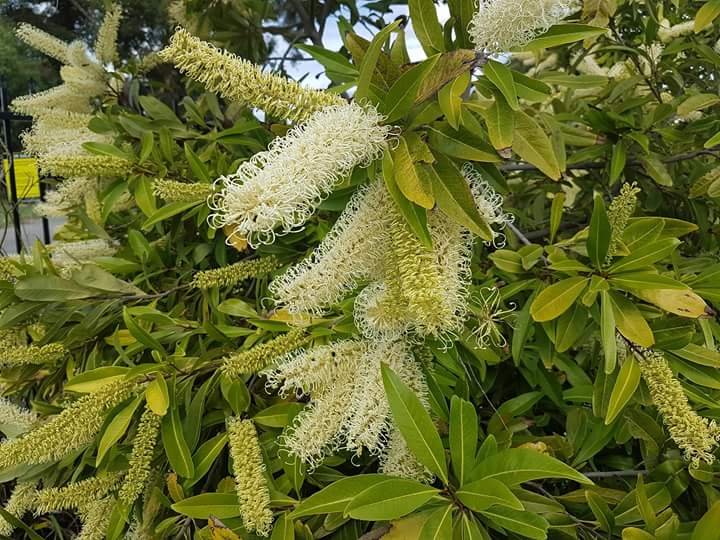 They grow naturally only ( endemic ) in the rainforests of the wet tropics region of north eastern Queensland , Australia.The ivory curl flower , B. celsissima , is the well known, popular and widely cultivated species in gardens and parks, in eastern and southern mainland Australia, and additionally as street trees northfrom about Brisbane. The second species, B. ferruginiflora , was only recently described in 1998.
They grow naturally only ( endemic ) in the rainforests of the wet tropics region of north eastern Queensland , Australia.The ivory curl flower , B. celsissima , is the well known, popular and widely cultivated species in gardens and parks, in eastern and southern mainland Australia, and additionally as street trees northfrom about Brisbane. The second species, B. ferruginiflora , was only recently described in 1998.  HISTORY,CLASSIFICATION AND EVOLUTION:- The genus was named in 1868 by Ferdinand von Mueller in honour of Richard Grenville , the Duke of Buckingham, who was Secretary of State for the Colonies from 1866 to 1868.It was initially placed in a tribe Grevilleae, but the feature of having four ovules per carpel led C. Venkata Rao to classify it in the tribe Telopeae, and within this a new subtribe Hollandaeae based on the antero-posterior orientation of the perianth, with the genera Hollandaea , Cardwellia , Knightia , Opisthiolepis and Stenocarpus .
HISTORY,CLASSIFICATION AND EVOLUTION:- The genus was named in 1868 by Ferdinand von Mueller in honour of Richard Grenville , the Duke of Buckingham, who was Secretary of State for the Colonies from 1866 to 1868.It was initially placed in a tribe Grevilleae, but the feature of having four ovules per carpel led C. Venkata Rao to classify it in the tribe Telopeae, and within this a new subtribe Hollandaeae based on the antero-posterior orientation of the perianth, with the genera Hollandaea , Cardwellia , Knightia , Opisthiolepis and Stenocarpus . 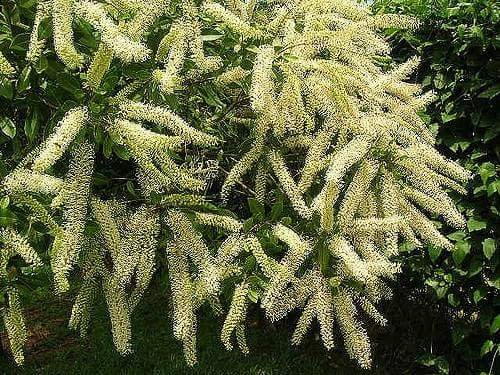 Lawrie Johnson and Barbara G. Briggs recognised the affinities of this genus with the rainforest taxon Opisthiolepis and classified the two in the subtribe Buckinghamiinae within the tribe Embothrieae in the subfamily Grevilleoideae in their 1975 monograph " On the Proteaceae: the evolution and classification of a southern family ", and thus related to Lomatia , Stenocarpus and the Embothriinae.However, analysis of chloroplast sequences revealed a much closer relationship of Buckinghamia and Opisthiolepis with Grevillea instead. Both genera have eleven pairs of chromosomes , which is reduced further in Grevillea . More recent evolutionary botanical science confirms that they correlate closest with the genera Opisthiolepis , Finschia , Grevillea and Hakea in the subtribe Hakeinae , with Buckinghamia and Opisthiolepis as two early offshoots from the ancestors of the other three genera.
Lawrie Johnson and Barbara G. Briggs recognised the affinities of this genus with the rainforest taxon Opisthiolepis and classified the two in the subtribe Buckinghamiinae within the tribe Embothrieae in the subfamily Grevilleoideae in their 1975 monograph " On the Proteaceae: the evolution and classification of a southern family ", and thus related to Lomatia , Stenocarpus and the Embothriinae.However, analysis of chloroplast sequences revealed a much closer relationship of Buckinghamia and Opisthiolepis with Grevillea instead. Both genera have eleven pairs of chromosomes , which is reduced further in Grevillea . More recent evolutionary botanical science confirms that they correlate closest with the genera Opisthiolepis , Finschia , Grevillea and Hakea in the subtribe Hakeinae , with Buckinghamia and Opisthiolepis as two early offshoots from the ancestors of the other three genera. 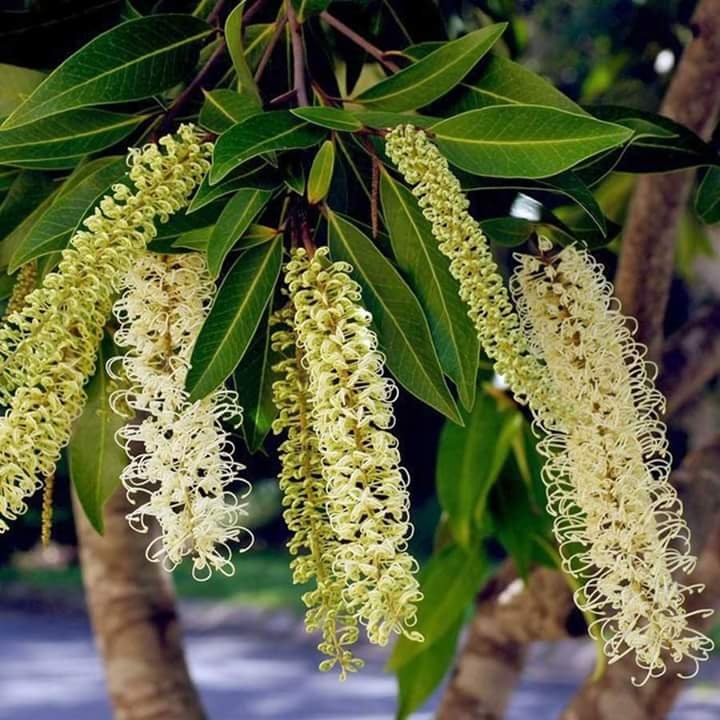 DESCEIPTIONS:-Buckinghamia celsissima (ivory curl flower) trees grow up to about 10 m (35 ft) tall in Australian gardens, parks and botanic gardens and much taller naturally to about 30 m (100 ft).The leaves are glossy dark green, and either lobed or entire, with new growth flushed pink. Spectacular in flower, they bear long showy sprays of sweetly fragrant, creamy- white flowers in summer. In a garden they can grow in full sun or part shade, and will attract birds and bees. Hardy and spectacular trees, they make ideal screens or windbreaks in a garden.
DESCEIPTIONS:-Buckinghamia celsissima (ivory curl flower) trees grow up to about 10 m (35 ft) tall in Australian gardens, parks and botanic gardens and much taller naturally to about 30 m (100 ft).The leaves are glossy dark green, and either lobed or entire, with new growth flushed pink. Spectacular in flower, they bear long showy sprays of sweetly fragrant, creamy- white flowers in summer. In a garden they can grow in full sun or part shade, and will attract birds and bees. Hardy and spectacular trees, they make ideal screens or windbreaks in a garden. 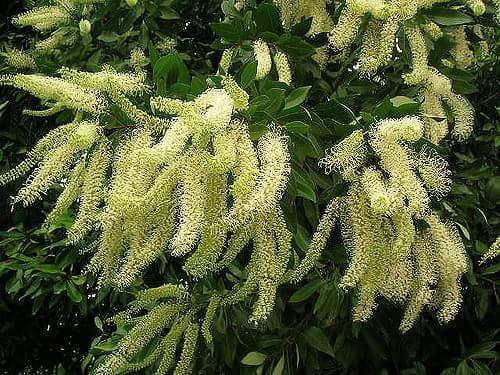 celsissima (ivory curl flower) trees in the botanic gardens in Adelaide, Melbourne, Sydney and Brisbane have been in cultivation for over a hundred years. They grow outdoors successfully in places as temperate as the Royal Botanic Gardens, Melbourne . Its notable landscape designer and director William Guilfoyle already had them growing there over one hundred years ago,resulting today in beautifully flowering, slow growing, established small trees. In the same late 1800s period the Adelaide Botanic Gardens already had them in cultivation also.They are popular and widely cultivated in many parks and gardens in coastal regions of eastern and southern mainland Australia, notably also their long history of planting in Brisbane as street trees. thanks to sharing for your great post..my dear friend @ctrl-alt-nwo very well done.
celsissima (ivory curl flower) trees in the botanic gardens in Adelaide, Melbourne, Sydney and Brisbane have been in cultivation for over a hundred years. They grow outdoors successfully in places as temperate as the Royal Botanic Gardens, Melbourne . Its notable landscape designer and director William Guilfoyle already had them growing there over one hundred years ago,resulting today in beautifully flowering, slow growing, established small trees. In the same late 1800s period the Adelaide Botanic Gardens already had them in cultivation also.They are popular and widely cultivated in many parks and gardens in coastal regions of eastern and southern mainland Australia, notably also their long history of planting in Brisbane as street trees. thanks to sharing for your great post..my dear friend @ctrl-alt-nwo very well done.
magoo-2 found a series of multi accounts of a same owner is following your articles to cheat your generous rewards.
magoo-2 found these accounts are suspicious & can be multi accounts of a single owner. Conclusion is based on last 30 days transactions:
@timuann @rahulsen
magoo-2
Check our latest multi comment spam update report
you are a really rubbish in the steemit platform. always doing bed work this platform and telling false talk every man comment.every man fake only you are real.really laughing..because you are a real spamear in this steemit platform.very bed.. @magoo-2
again telling false word in your comment.its really not your limitation.everything stayed needs limit.excess is a very bed..@magoo-2 stop your rubbish work..
Buckinghamia celsissima is a handsome evergreen tree with a rounded canopy, it can be grown as shrub.

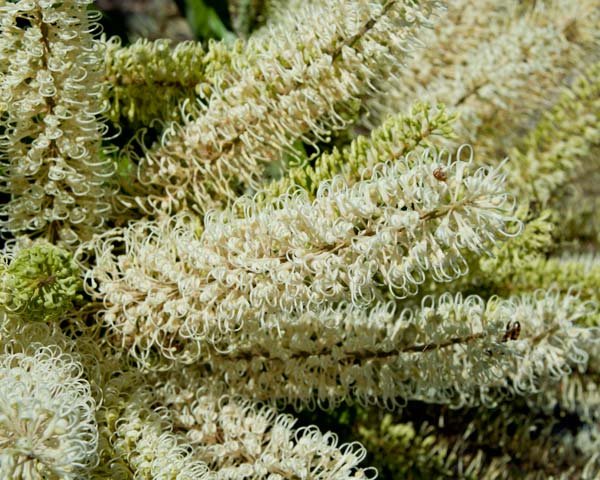
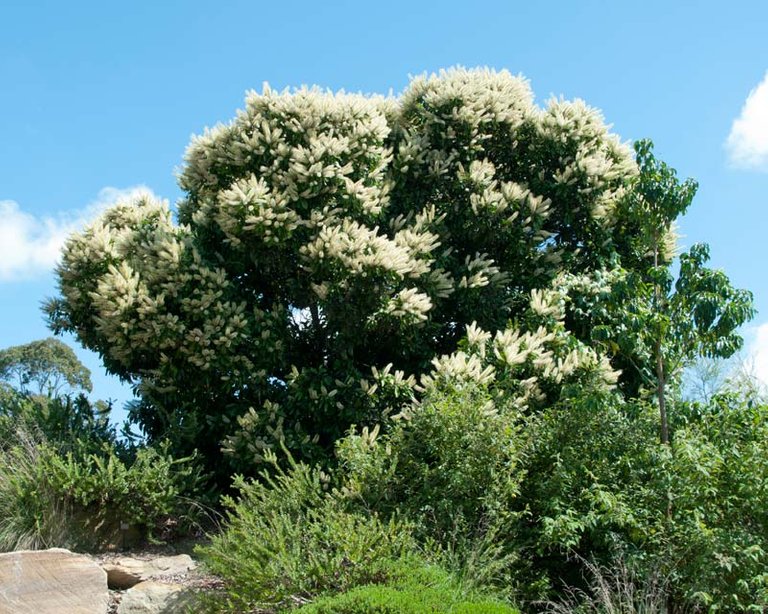
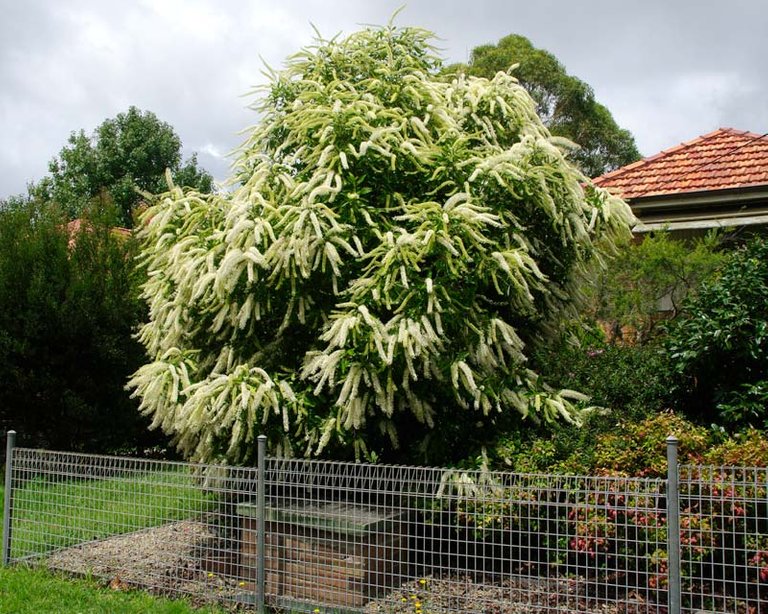
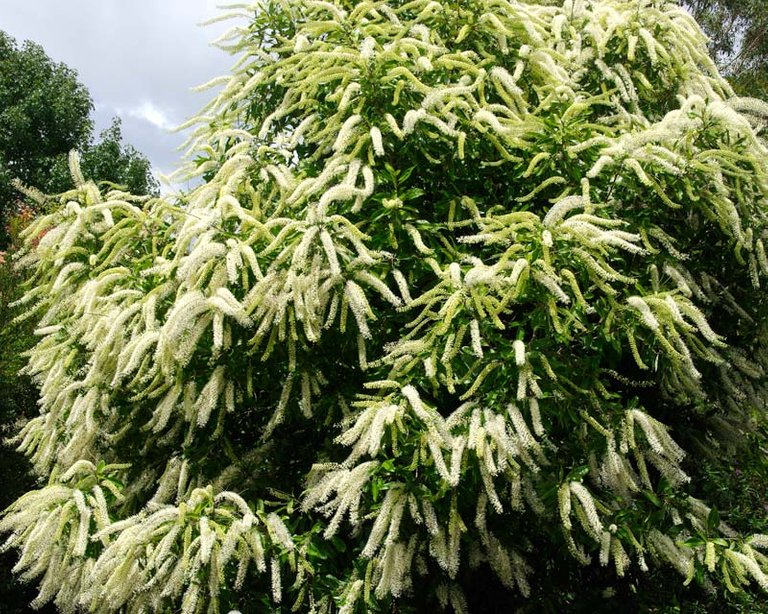
In the tropical regions it can be a fast growing tree and in its native habitat can grow to 30m. In cooler climates, as far south as Sydney, it is quite slow growing and seldom grows more than 8m.
Mature trees have leaves are large, deep green, glossy and elliptical, with a silvery underside. In younger trees the leaves tend to be irregularly lobed.
From summer to early autumn it is covered with masses of racemes of creamy white, sweetly scented saccate flowers clustered at the ends of the branches.
The Ivory Curl Flower prefers warm coastal climates, it does not tolerate frost or salt and like all PROTEACEAE it is phosphorus intolerant.
Can be grown as a feature plant or part of shrubbery.
Soil: Moist well drained soils with added organic matter. Will tolerate occasional short periods of drought.
Maintenance: A light pruning once a year after flowering will keep it tidy.
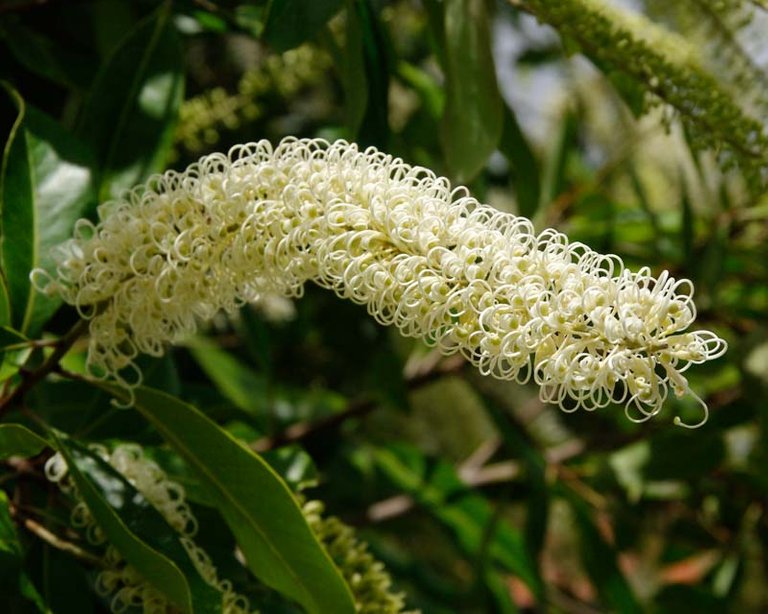
Feed in spring with low phosphorus fertilizers for Australian Natives.
Other Species: Just this one.
Comments: Named after Richard Grenville, the Duke of Buckingham.
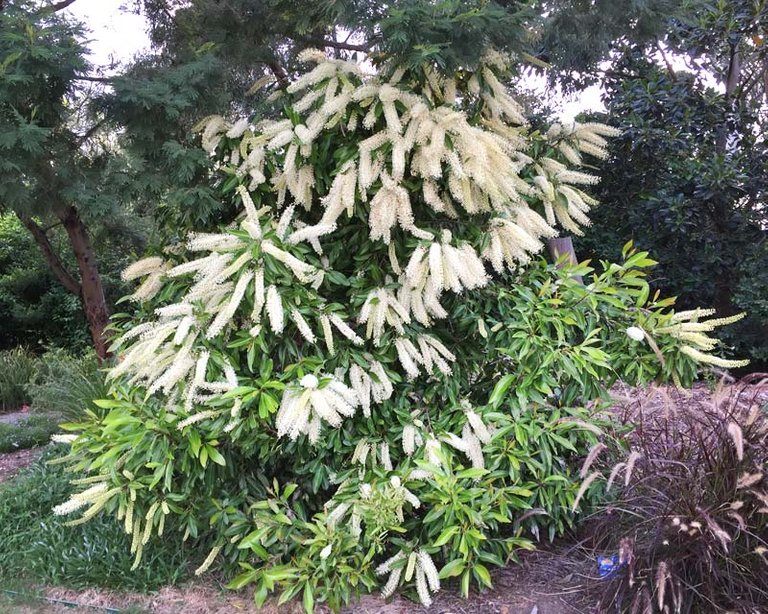
The name is from Latin celsus, high or lofty, a reference to the habit of the plant in the wild
These have been used for street planting in Sydney at times.
Magoo-2 found a series of multi accounts of a same owner is following your articles to cheat your generous rewards.
Magoo-2 found these accounts are suspicious & can be multi accounts of a single owner. Conclusion is based on last 30 days transactions:
@moniristi @shishiristi
magoo-2
Check our latest multi comment spam update report
buckinghamia celsissima trees grow up to about 10 m or 35 ft tall in Australian gardens, parks and botanic gardens and much taller naturally to about 30 m or 100 ft.The leaves are glossy dark green, and either lobed or entire, with new growth flushed pink. Spectacular in flower, they bear long showy sprays of sweetly fragrant, creamy-white flowers in summer. In a garden they can grow in full sun or part shade, and will attract birds and bees. Hardy and spectacular trees, they make ideal screens or windbreaks in a garden.

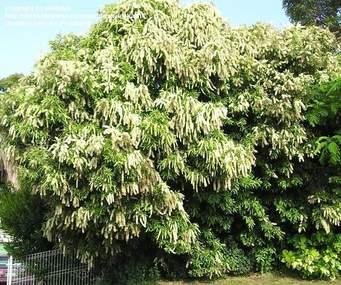
lovely
check this out..
Its great to see very beautiful plant you share us.@ctrl-alt-nwo i'm new join steemit.
Buckinghamia celsissima F.Muell., ivory curl, ivory curl flower, spotted silky oak, buckinghamia silky oak .
.
Buckinghamia ferruginiflora Foreman & B.Hyland
Buckinghamia celsissima (ivory curl flower) trees grow up to about 10 m (35 ft) tall in Australian gardens, parks and botanic gardens and much taller naturally to about 30 m (100 ft). The leaves are glossy dark green, and either lobed or entire, with new growth flushed pink. Spectacular in flower, they bear long showy sprays of sweetly fragrant, creamy-white flowers in summer. In a garden they can grow in full sun or part shade, and will attract birds and bees. Hardy and spectacular trees, they make ideal screens or windbreaks in a garden
B. celsissima (ivory curl flower) trees in the botanic gardens in Adelaide, Melbourne, Sydney and Brisbane have been in cultivation for over a hundred years. They grow outdoors successfully in places as temperate as the Royal Botanic Gardens, Melbourne. Its notable landscape designer and director William Guilfoyle already had them growing there over one hundred years ago,resulting today in beautifully flowering, slow growing, established small trees.In the same late 1800s period the Adelaide Botanic Gardens already had them in cultivation also.They are popular and widely cultivated in many parks and gardens in coastal regions of eastern and southern mainland Australia, notably also their long history of planting in Brisbane as street trees
#source
A beautiful plant, my friend!
Buckinghamia celsissima
Family: Proteaceae
Distribution: Rainforests of northern Queensland.
Common Name: Ivory curl
Derivation of Name: Buckinghamia....after Richard Grenville, Duke of Buckingham.
celsissima....from Latin celsus, high or lofty, a reference to the habit of the plant in the wild.
Conservation Status: Not considered to be at risk in the wild.
General Description:
The genus Buckinghamia comprises two species. Apart from B.celsissima, the only other species is B.ferruginiflora, a rare plant from north-east Queensland.
B.celsissima is a tall tree to 30 metres in height in its natural habitat but is much smaller in cultivation, particularly in cooler climates where it rarely exceeds 7-8 metres. It has attractive foliage - the juvenile leaves are often lobed while the new growth is an attractive bronze colour. Mature leaves are elliptical and entire and about 150 mm long. Flowers are white to cream and occur in summer in large racemes up to 200 mm long. The flowers are well displayed at the ends of the branches.
The ivory curl plant performs well in cultivation even in much cooler areas to its natural habitat. Good specimens can be found in Sydney and Melbourne. It requires a reasonably well drained, moist soil and a sunny position.
Propagation is reasonably easy from seed which should be sown when fresh. Cuttings of hardened, current season's growth are also successful. Thank you @ctrl-alt-nwo
http://www.anpsa.org.au/b-cels.html
Buckinghamia celsissima.
Plant family: Proteaceae.
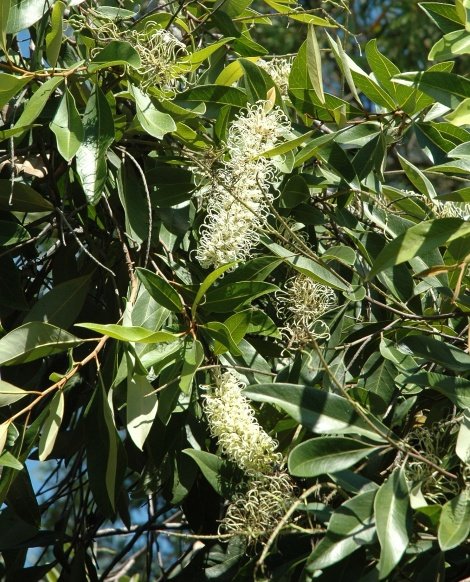
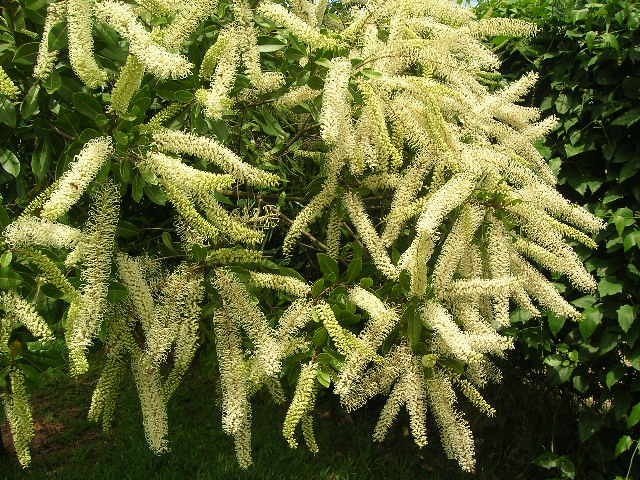
A fast growing evergreen tree that produces long, elegant ivory coloured flower spires that are sweetly fragrant. Will start flowering after 3 to 5 year.
Flowers appear in summer, through to autumn.
Tolerant of most soil types, but prefers a deep, organically rich soil with regular access to moisture.

Plant in full sun to part shade.
Widely used as a street tree and urban planting in parks and common areas.
Grows 7 to 9 m tall

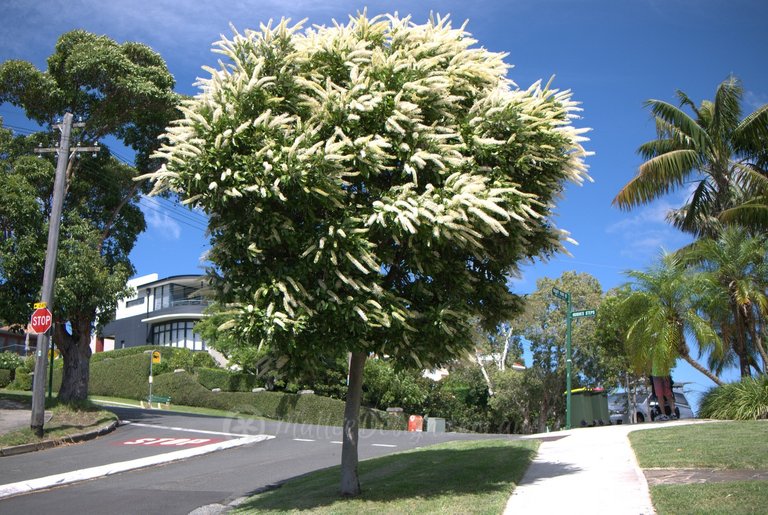
Habitat: Indigenous to the rainforests of North Eastern Queensland, this beautiful tree can reach heights of 30 m as it stretches to compete for light.
Host plant for the Indigo Flash, Bright Cornelian, Small Purple Line-Blue and Common Pencilled-Blue butterflies, birds, bees and other beneficial insects.
Wow amazing & beautiful Buckinghamia flowers garden.

For your post propagation.
Upvote/Resteem
So beautiful garden, thanks for sharing
Resteem
Buckinghamia celsissima
https://cdn.steemitimages.com/0x0/https://ipfs.busy.org/ipfs/QmSzKoUAK7KaTtBX8wvjexZZPFfqx8dNxG6Z9VhosyJ4B6
Buckinghamia celsissima is commonly called the Ivory Curl Tree. It's a native of North Eastern Queensland, and for years was widely planted as a street tree around Brisbane.
In flower, it's stunning and a great plant for most gardens. The trees grow naturally in rainforests in Queensland and northern New South Wales, but also grow happily throughout most of Australia, including as far south as Melbourne. However Buckinghamia celsissima doesn't do well in Canberra, because it hates frosts, and it will not flower in the humidity and heavy rains of the northern tropics.
In its natural rainforest it grows to about 25 metres to reach the light above the tree canopy. In suburban gardens expect a small tree up to about eight metres, and in the cooler southern states it will reach the size of a medium shrub. The long creamy re-curved flowers are borne in autumn, have a wonderful fragrance and are also attractive to birds and bees.
Buckinghamia celsissima is a great plant - it doesn't seem to suffer pests and diseases, is adaptable and will grow in many areas of Australia.
http://www.abc.net.au/gardening/factsheets/buckinghamia-celsissima/9423910
Buckinghamia celsissima
General Description:
The genus Buckinghamia comprises two species. Apart from B.celsissima, the only other species is B.ferruginiflora, a rare plant from north-east Queensland
B.celsissima is a tall tree to 30 metres in height in its natural habitat but is much smaller in cultivation, particularly in cooler climates where it rarely exceeds 7-8 metres. It has attractive foliage - the juvenile leaves are often lobed while the new growth is an attractive bronze colour. Mature leaves are elliptical and entire and about 150 mm long. Flowers are white to cream and occur in summer in large racemes up to 200 mm long. The flowers are well displayed at the ends of the branches.
The ivory curl plant performs well in cultivation even in much cooler areas to its natural habitat. Good specimens can be found in Sydney and Melbourne. It requires a reasonably well drained, moist soil and a sunny position.
Propagation is reasonably easy from seed which should be sown when fresh. Cuttings of hardened, current season's growth are also successful.
http://www.anpsa.org.au/b-cels.html
The genus was named in 1868 by Ferdinand von Mueller in honour of Richard Grenville, the Duke of Buckingham,who was Secretary of State for the Colonies from 1866 to 1868.It was initially placed in a tribe Grevilleae, but the feature of having four ovules per carpel led C. Venkata Rao to classify it in the tribe Telopeae, and within this a new subtribe Hollandaeae based on the antero-posterior orientation of the perianth, with the genera Hollandaea, Cardwellia, Knightia, Opisthiolepis and Stenocarpus.
Lawrie Johnson and Barbara G. Briggs recognised the affinities of this genus with the rainforest taxon Opisthiolepis and classified the two in the subtribe Buckinghamiinae within the tribe Embothrieae in the subfamily Grevilleoideae in their 1975 monograph "On the Proteaceae: the evolution and classification of a southern family", and thus related to Lomatia, Stenocarpus and the Embothriinae.However, analysis of chloroplast sequences revealed a much closer relationship of Buckinghamia and Opisthiolepis with Grevillea instead. Both genera have eleven pairs of chromosomes, which is reduced further in Grevillea. More recent evolutionary botanical science confirms that they correlate closest with the genera Opisthiolepis, Finschia, Grevillea and Hakea in the subtribe Hakeinae, with Buckinghamia and Opisthiolepis as two early offshoots from the ancestors of the other three genera.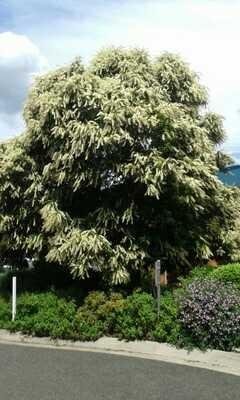

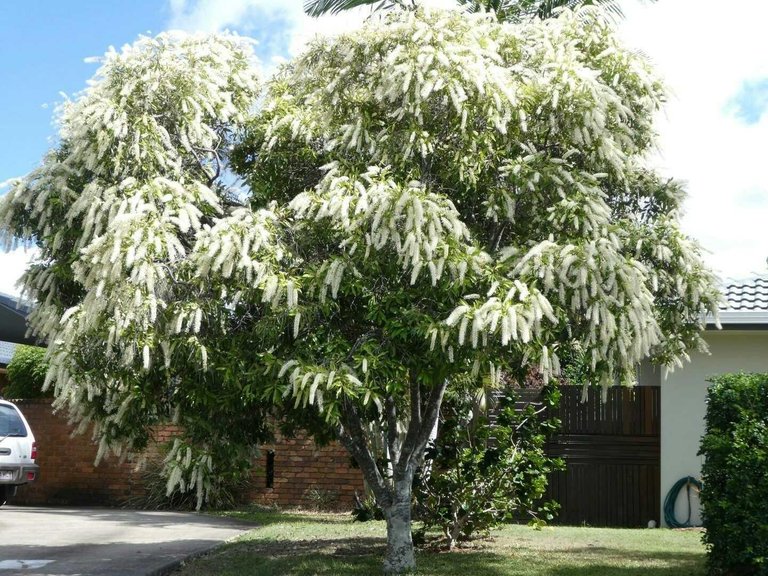
Buckinghamia celsissima, commonly known as the ivory curl, is a species of trees, constituting part of the plant family Proteaceae. They grow naturally only (endemic) in the wet tropics rainforests areas of north eastern Queensland, Australia.
The species was described in 1868 by Ferdinand von Mueller in honour of Richard Grenville, 3rd Duke of Buckingham, from a collection of material made by John Dallachy near Rockingham Bay on 11 January 1865. Its specific epithet is Latin for "very tall". Common names include ivory curl flower and spotted silky oak.
Buckinghamia celsissima reaches 30 m (98 ft) tall in its natural rainforest habitat, but is much smaller, reaching 10 m (33 ft) tall, in Australian east coast gardens. Glossy dark green above and whitish below, the leaves are quite variable. Juvenile leaves have one or more lobes while adult leaves are simple and entire, measuring 8 to 16 cm (3.1 to 6.3 in) long by 3–7 cm (1.2–2.8 in) wide.
Source
Buckinghamia is a beautiful plant. It's

generally called the Ivory Curl Tree. It's a local of North Eastern Queensland, and for a considerable length of time was broadly planted as a road tree around Brisbane.
source
In bloom, it's shocking and an incredible plant for generally cultivates. The trees develop normally in rainforests in Queensland and northern New South Wales, yet in addition develop cheerfully all through a large portion of Australia, including as far south as Melbourne. Anyway Buckinghamia celsissima doesn't do well in Canberra, since it despises ices, and it won't bloom in the dampness and substantial downpours of the northern tropics.
source
In its common rainforest it develops to around 25 meters to achieve the light over the tree shade. In rural greenery enclosures expect a little tree up to around eight meters, and in the cooler southern states it will achieve the span of a medium bush. The long velvety re-bended blooms are borne in harvest time, have a brilliant scent and are likewise alluring to fowls and honey bees.
source
Buckinghamia celsissima is an extraordinary plant - it doesn't appear to endure vermin and maladies, is versatile and will develop in numerous territories of Australia.
source
Thank you sir @ctrl-alt-nwo for always dharing some beautiful flowers as your mind is so pure.
Wonderful Australia Buckinghamia Plant. this is valuable article.
@ctrl-alt-nwo
This is a stunning plant in cultivation where it grows into a spectacular flowering medium to large shrub or small tree. In the wild in the rainforests of north Queensland it can grow into a small to medium sized tree but it rarely grows beyond shrub dimensions in cultivation, particularly in cooler climates such as Melbourne. It flowers in autumn, with the long creamy flowerheads often completely hiding the dark green glossy foliage. It makes a wonderful feature plant and should be trimmed back behind the spent flowers.
Scientific Name: Buckinghamia celsissima
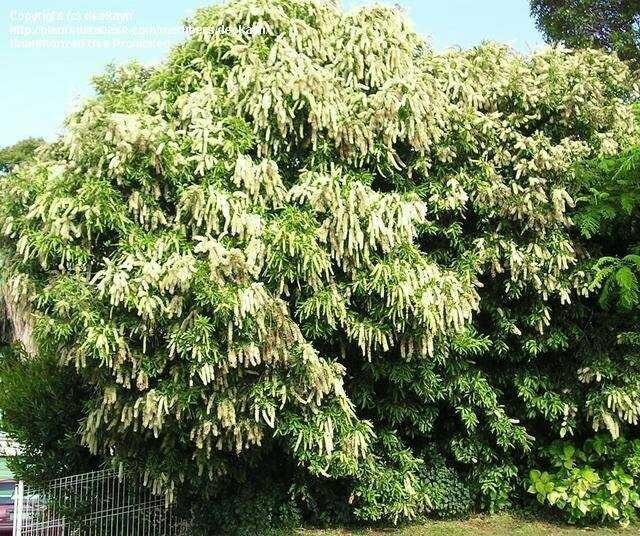
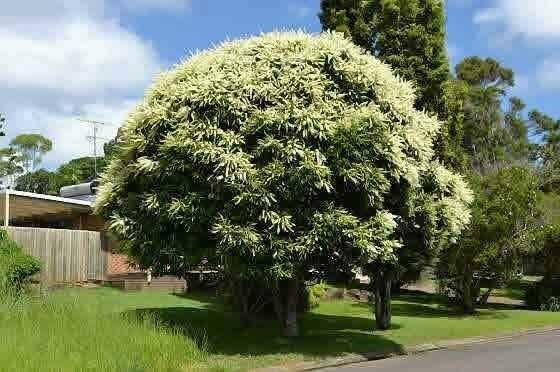
Family: Proteaceae
Common Name: Ivory Curl Tree
Plant Type: Small tree, Large tree
Height: 8 ~ 25 metres
Width: 1 ~ 4 metre
Flower Colour: White, Cream
Flowering Time: Summer
Ph Level: Acid, Neutral
Soil Type: Loamy, Sandy loam, Clay loam
Plant Environment: Low maintenance garden, Flower garden
Climate Zone: Sub-tropical, Warm temperate
Light: Sunny, Light shade
Growth Habit: Evergreen, Dense foliage
Soil Moisture: Well-drained, Moist moderate drainage
Propagation Method: Seed, Softwood cutting, Semihardwood cutting, Layering
Frost Tolerance: Tolerates light frost
Plant Usage: Feature plant, Screen, Windbreak, Wow factor
Special Uses: Street tree, Erosion control, Honey producing plant, Playground friendly
Attracts Wildlife: Bees, Nectar eating birds, Butterflies, Other insects
source
Buckinghamia is commonly called the Ivory Curl Tree. It's a native of North Eastern Queensland, and for years was widely planted as a street tree around Brisbane.
In flower, it's stunning and a great plant for most gardens. The trees grow naturally in rainforests in Queensland and northern New South Wales, but also grow happily throughout most of Australia, including as far south as Melbourne.
In its natural rainforest it grows to about 25 metres to reach the light above the tree canopy. In suburban gardens expect a small tree up to about eight metres, and in the cooler southern states it will reach the size of a medium shrub.
The long creamy re-curved flowers are borne in autumn, have a wonderful fragrance and are also attractive to birds and bees.
Buckinghamia is a great plant - it doesn't seem to suffer pests and diseases, is adaptable and will grow in many areas of Australia.
Source:http://www.abc.net.au/gardening/factsheets/buckinghamia-celsissima/9423910
magoo-2 found a series of multi accounts of a same owner is following your articles to cheat your generous rewards.
magoo-2 found these accounts are suspicious & can be multi accounts of a single owner. Conclusion is based on last 30 days transactions:
@pijon @russelkhan
magoo-2
Check our latest multi comment spam update report
Buckinghamia – Ivory Curl Tree
This is a stunning plant in cultivation where it grows into a spectacular flowering medium to large shrub or small tree. In the wild in the rainforests of north Queensland it can grow into a small to medium sized tree but it rarely grows beyond shrub dimensions in cultivation, particularly in cooler climates such as Melbourne. It flowers in autumn, with the long creamy flowerheads often completely hiding the dark green glossy foliage. It makes a wonderful feature plant and should be trimmed back behind the spent flowers.
#AlarmyStock
Very beautiful plant you share today @ctrl-alt-nwo
Buckinghamia celsissima (ivory curl flower) trees grow up to about 10 m (35 ft) tall in Australian gardens, parks and botanic gardens and much taller naturally to about 30 m (100 ft).The leaves are glossy dark green, and either lobed or entire, with new growth flushed pink. Spectacular in flower, they bear long showy sprays of sweetly fragrant, creamy-white flowers in summer. In a garden they can grow in full sun or part shade, and will attract birds and bees. Hardy and spectacular trees, they make ideal screens or windbreaks in a garden
B. celsissima (ivory curl flower) trees in the botanic gardens in Adelaide, Melbourne, Sydney and Brisbane have been in cultivation for over a hundred years. They grow outdoors successfully in places as temperate as the Royal Botanic Gardens, Melbourne. Its notable landscape designer and director William Guilfoyle already had them growing there over one hundred years ago,resulting today in beautifully flowering, slow growing, established small trees.In the same late 1800s period the Adelaide Botanic Gardens already had them in cultivation also.They are popular and widely cultivated in many parks and gardens in coastal regions of eastern and southern mainland Australia, notably also their long history of planting in Brisbane as street trees
@source
Ivory curls are a species of tree, native to Queensland rainforest habitats north of Townsville, in north eastern Australia. They are beautiful. After reading up on them I found out that their root systems aren’t too invasive hence why they are great being planted near the streets and yet, in the wild they can grow to be very tall. They grow best in low humidity tropical conditions, particularly in full sunlight, although it is a hardy tree, and tends to be drought tolerant, as well as resistant to many diseases and pests.
Source
The flower spikes of ivory curls form a long, cylindrical shape, and are typically cream to white in colour. They are commonly grown for ornamental purposes, especially as street or garden trees.
Source
The leaves of ivory curls are smooth and a lush green on the upper side, while the underneath tends to be a lighter silvery white colour, and they generally grow to be 8 to 16 centimetres (3.1 to 6.3 inches) in length.
Source
Ivory curl trees generally bloom profusely during the months of summer and autumn, and the flowers are fragrant, and birds and bees are attracted to them.
Source
The Ivory Curl does produce a small brown fruit. The fruit has a winged appearance to it, and it is not meant to be eaten by anyone, including animals.
Source
Buckinghamia in sri lanka
This is particularly suitable for gardens in Sri Lanka.
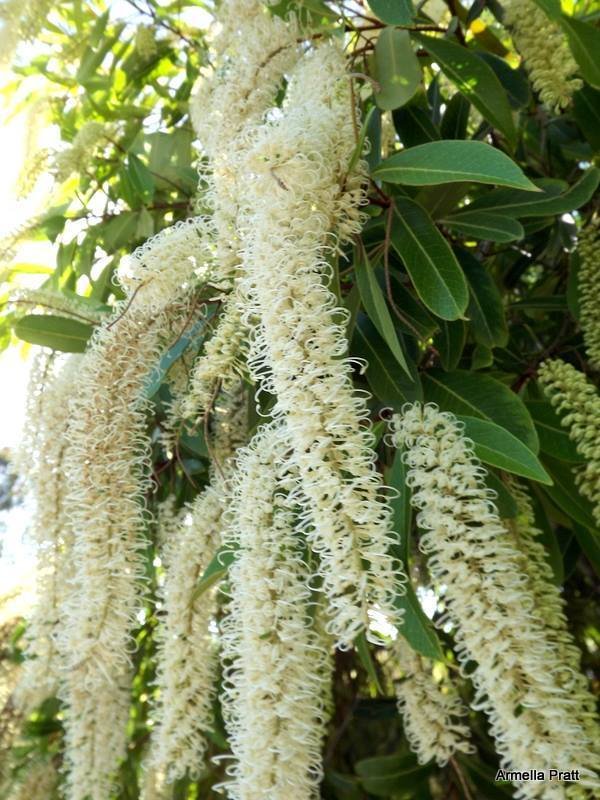
Especially this is Nuwara Eliya.
Buckinghamia is a genus of only two known species of trees, belonging to the family Proteaceae. They grow naturally only (endemic) in the rainforests of the wet tropics region of north eastern Queensland, Australia. The Fire Wheel Tree (or Ivory Curl Flower), Buckinghamia celsissima, is the well known, popular and widely cultivated species in gardens and parks, in eastern and southern mainland Australia, and additionally as street trees north from about Brisbane.

The genus was named in 1868 by Ferdinand von Mueller in honour of Richard Grenville, the Duke of Buckingham, who was Secretary of State for the Colonies from 1866 to 1868.
 Thanks @ctrl-alt-nwo this post
Thanks @ctrl-alt-nwo this post
Have a great day
That is a amazing trees and really looks for flowers. the great Buckinghamia garden.
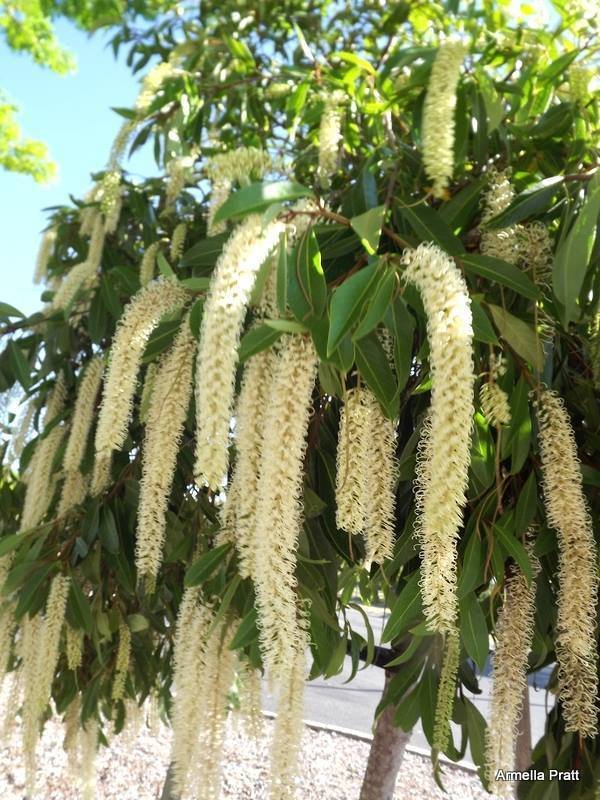
Thanks for the information.
100% upvote Resteem
Ivory curl trees tick all the boxes as they’re fast growing and easy to care for with spectacular flowers that attract birds. What more could you want? Well they also happen to be an Australian native! Now you’ve just got to get one 🙂
Botanically they are called Buckinghamia celsissima but ivory curl tree is just a bit easier on the tongue. This common name perfectly describes their curled ivory coloured flowers which appear from late summer through into autumn. They are produced on the ends of branches and are full of nectar which attracts birds and bees alike.
Ivory curl trees have a lovely dense umbrella shape, with attractive glossy green foliage. New growth often has a pinkish red tinge which provides interest even when not in flower. They are perfect as a feature tree or mass planted for privacy.
Originally from the tropical rainforests of eastern Queensland they are surprisingly adaptable and will even grow in areas with light frosts provided they are in a sheltered position. Trees usually develop into a nice shape naturally with little pruning required. Pruning can be done to restrict their height if necessary and spent flower heads can be trimmed off if they bother you.
Ivory curl trees seldom suffer from pests and diseases but occasionally scale, aphids and mites may attack. Control with a couple of sprays of eco-oil.
Photos collected from Google
How To Grow Buckinghamia
Originally from the tropical rainforests of eastern Queensland they are surprisingly adaptable and will even grow in areas with light frosts provided they are in a sheltered position.
Ivory curl trees can tolerate a wide range of soils but will benefit from good drainage with plenty of organic matter mixed in. The richer the soil the faster the growth. Plant in full sun to part shade and maintain moisture levels until well established. After this they are quite dry tolerant.
Actual tree height will be determined by your climate. In warmer regions they reach 6 to 8 metres (or even higher) but as the temperature drops, so does the height of the tree. This means in places like Sydney or Melbourne the ivory curl tree is more of a large shrub than a real tree.
Plants usually flower after 2-3 years.
Fertilising
To speed the growth of young plants apply eco-seaweed and eco-aminogro every 2-4 weeks during the warmer months. Established trees can be fertilise in spring and autumn with a Certified Organic pelletised fertiliser.
Pruning
Trees usually develop into a nice shape naturally with little pruning required. Pruning can be done to restrict their height if necessary and spent flower heads can be trimmed off if they bother you.
Pests and Diseases of Ivory Curl Trees


Ivory curl trees seldom suffer from pests and diseases but occasionally scale, aphids and mites may attack. Control with a couple of sprays of eco-oil.
sourceall
Buckinghamia Celsissima
Family: Proteaceae Origin: Rain forests from Mt Spec to Cooktown
The Ivory Curl is a beautiful feature tree often seen in the backyards and found in undisturbed bushland in its native area. According to the Australian Native Plants Society, the tree is named after Richard Greenville, the Duke of Buckingham. As the tree is common enough in the wild it is not considered to be at risk; proof of its hardiness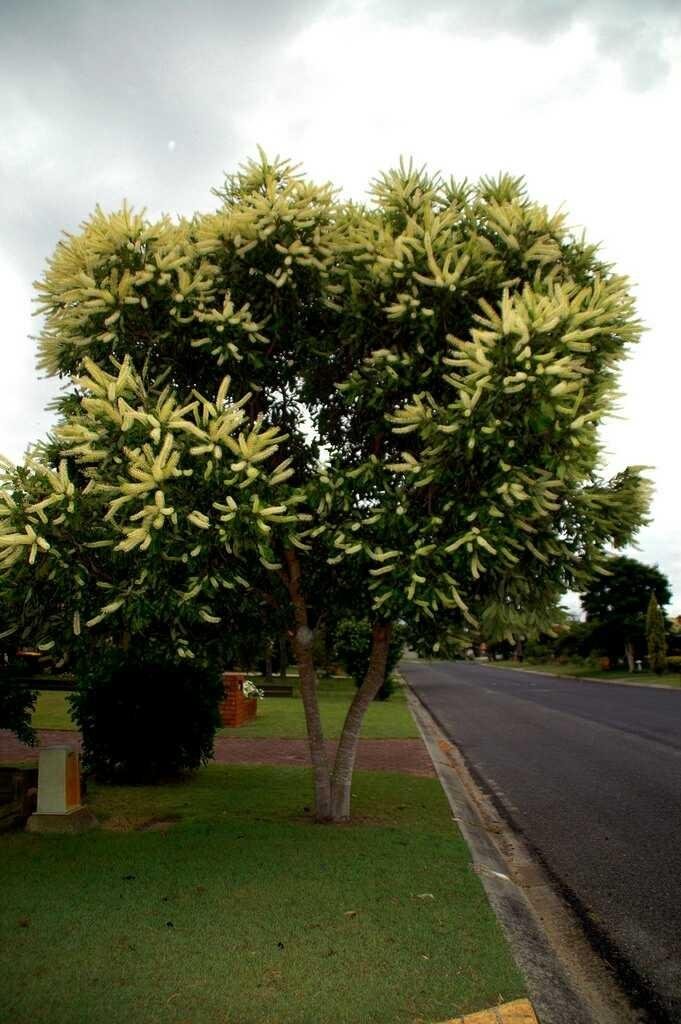
Ivory Curl, Buckinghamia celsissima
Fruit Production
The tree is not really known for its fruit production, but according to Discover NATURE, the Ivory Curl does produce a small brown fruit. The fruit has a winged appearance to it, and it is not meant to be eaten by anyone, including animals

Botanical Name:Buckinghamia celsissima
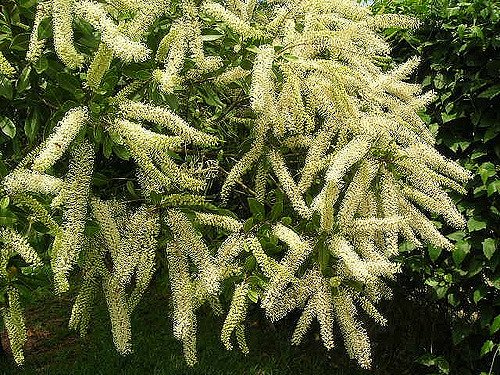
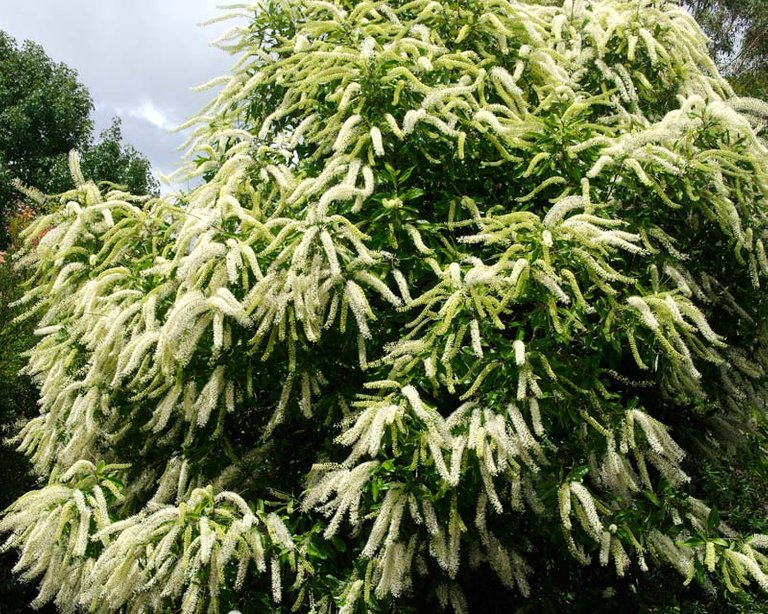

Stem:Oak grain in the wood and a corresponding pattern in the inner blaze.
Fruit:Follicles about 1.5-3 cm long. Seeds flat with a narrow marginal wing.
Natural History:Food plant for the larval stages of the Cornelian Butterfly. Common & Waterhouse (1981).
Widely cultivated in a variety of situations from street trees to gardens and known for the ease of culture, the good form and the mass flowerings it produces.Produces a useful general purpose timber with a conspicuous oak grain.

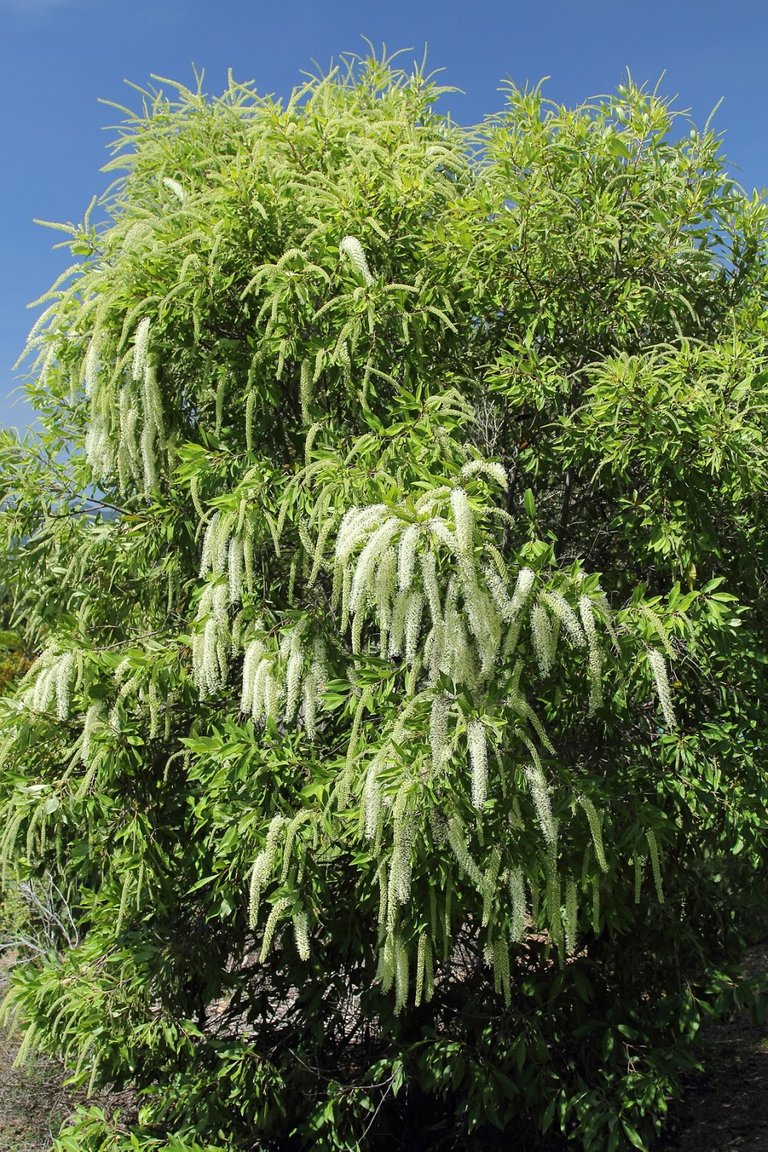.JPG)
Info-http://keys.trin.org.au/key-server/data/0e0f0504-0103-430d-8004-060d07080d04/media/Html/taxon/Buckinghamia_celsissima.htm
Buckinghamia celsissima is a handsome evergreen tree with a rounded canopy, it can be grown as shrub. In the tropical regions it can be a fast growing tree and in its native habitat can grow to 30m. In cooler climates, as far south as Sydney, it is quite slow growing and seldom grows more than 8m.
Mature trees have leaves are large, deep green, glossy and elliptical, with a silvery underside. In younger trees the leaves tend to be irregularly lobed. From summer to early autumn it is covered with masses of racemes of creamy white, sweetly scented saccate flowers clustered at the ends of the branches.
The Ivory Curl Flower prefers warm coastal climates, it does not tolerate frost or salt and like all PROTEACEAE it is phosphorus intolerant. Can be grown as a feature plant or part of shrubbery.
Moist well drained soils with added organic matter. Will tolerate occasional short periods of drought. A light pruning once a year after flowering will keep it tidy. Feed in spring with low phosphorus fertilizers for Australian Natives.
Named after Richard Grenville, the Duke of Buckingham. The name is from Latin celsus, high or lofty, a reference to the habit of the plant in the wild.
#Source:Google
Botanically they are called Buckinghamia celsissima but ivory curl tree is just a bit easier on the tongue. This common name perfectly describes their curled ivory coloured flowers which appear from late summer through into autumn. They are produced on the ends of branches and are full of nectar which attracts birds and bees alike.
Ivory curl trees have a lovely dense umbrella shape, with attractive glossy green foliage. New growth often has a pinkish red tinge which provides interest even when not in flower. They are perfect as a feature tree or mass planted for privacy.
Ivory curl trees can tolerate a wide range of soils but will benefit from good drainage with plenty of organic matter mixed in. The richer the soil the faster the growth. Plant in full sun to part shade and maintain moisture levels until well established. After this they are quite dry tolerant.
Actual tree height will be determined by your climate. In warmer regions they reach 6 to 8 metres (or even higher) but as the temperature drops, so does the height of the tree. This means in places like Sydney or Melbourne the ivory curl tree is more of a large shrub than a real tree.
source of information
Buckinghamia celsissima is a handsome evergreen tree with a rounded canopy, it can be grown as shrub.
In the tropical regions it can be a fast growing tree and in its native habitat can grow to 30m. In cooler climates, as far south as Sydney, it is quite slow growing and seldom grows more than 8m.
Mature trees have leaves are large, deep green, glossy and elliptical, with a silvery underside. In younger trees the leaves tend to be irregularly lobed.
From summer to early autumn it is covered with masses of racemes of creamy white, sweetly scented saccate flowers clustered at the ends of the branches.
The Ivory Curl Flower prefers warm coastal climates, it does not tolerate frost or salt and like all PROTEACEAE it is phosphorus intolerant.
Can be grown as a feature plant or part of shrubbery.
Moist well drained soils with added organic matter. Will tolerate occasional short periods of drought.
A light pruning once a year after flowering will keep it tidy. Feed in spring with low phosphorus fertilizers for Australian Natives. These have been used for street planting in Sydney at times.
source
Buckinghamia is an ornamental and timber tree native to Australia, its natural range limited to small areas of humid tropical forest in the north-east of the continent.
It is a tall tree in closely spaced forests, reaching heights of up to 30 m (100 ft) with a straight, buttressed trunk up to 40 cm (1.3 ft) in diameter supporting a narrow crown. On open sites, it is more typically 5 to 10 m (15 to 30 ft) tall with a densely branched rounded crown.
The bark on young trees is grey and smooth, with age becoming rough, thick and fissured. Growth is moderate to fast, depending on the growing conditions.
The leaves are bronze-red or pink-tinged when young becoming dark glossy green above, greyish underneath and have a tough, leathery texture. They change shape as they mature, from deeply lobed in juvenile form to entire, elongated-oval at maturity and remain on the tree throughout the year.
The flowers are cream white tubes coiled at the tip, closely arranged in bottle-brush-like flower spikes up to 25 cm (10 in) long. They come into bloom in summer in its native range, over a period lasting four to six week.
Source
Buckinghamia celsissima, commonly known as the ivory curl, belongs to family Proteaceae. They are native in the wet tropical rainforests in the north eastern Queensland, Australia. They also grow well in subtropical places. It is planted widely as a street tree in Sydney suburbs and many other places.
Buckinghamia celsissima produces inflorescences of curled ivory coloured flowers from late summer through into autumn. The flowers are full of nectar which attracts birds and bees alike.
The flower does not have separate petals or sepals but both structures fused together and form 4 perianths. Anthers are attached onto the end of the perianths. The pistil is made up of stigma, style and ovary. The stigma receives pollen grains. The ovary houses 4 ovules inside. After fertilization, the ovules develop into seeds and the ovary grows and develops into a fruit. The fruit is woody, 1.5–2 cm long.
SOURCE
Buckinghamia is a beautiful feature tree often seen in the backyards and found in undisturbed bushland in its native area. According to the Australian Native Plants Society, the tree is named after Richard Greenville, the Duke of Buckingham. As the tree is common enough in the wild it is not considered to be at risk; proof of its hardiness.
The tree is not really known for its fruit production, but according to Discover NATURE, the Ivory Curl does produce a small brown fruit. The fruit has a winged appearance to it, and it is not meant to be eaten by anyone, including animals.
The flowers on the Ivory Curl are possibly the crowning jewel of this tree. The times in which this flower really depends upon the weather, but for the most part this is spring time through early fall.
The flowers cluster together, to the point in which they appear to overtake each branch of the tree. The flowers are white with a yellow tint in color, and they do attract butterflies and bees when flowering.
In the wild, the Ivory Curl gets very tall with a bush at the top. However, in domestic sittings, the tree usually gets 6 or 8 meters high.
source